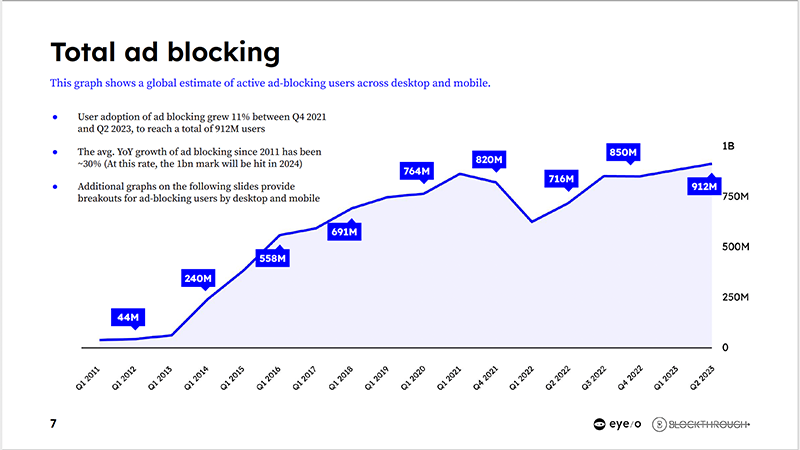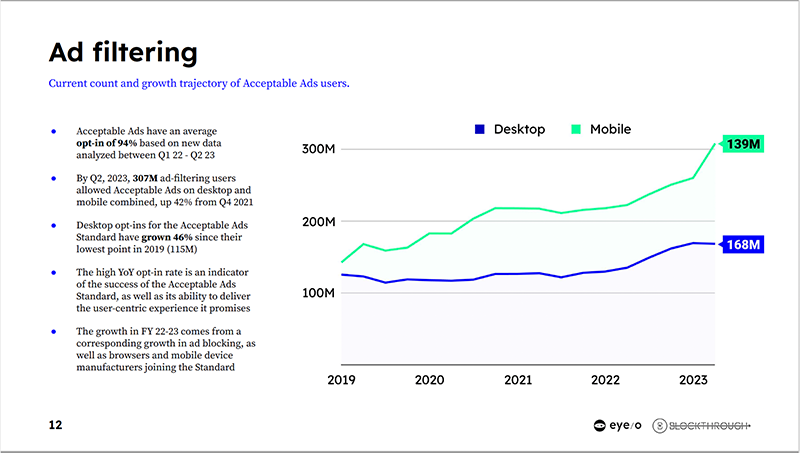
Ad blocking is on the rise again, set to cause $54 billion in ad revenue losses worldwide. But there’s a bright side to this story. More users are opting into Acceptable Ads and AI and machine learning will make ad filtering more effective.
Ad blocking may not be seen as big a threat as it was, say, eight years ago when the rise of ad block users was as steep as Canada’s Mount Thor. The topic certainly isn’t living rent-free in publishers’ minds the way the ever-present threat of signal loss is — despite the recent frenzy over YouTube’s ad-blocking crackdown.
Still, it could thwart a publisher’s revenue growth just like the handful of times The Clown Prince of Crime was able to one-up The Dark Knight in DC Comics. (The Joker vs. Batman, get it?) It’s one of those things we can’t imagine ever happening, but still, somehow it does.
The truth is, publishers around the world will lose $54 billion in ad revenue due to ad blocking in 2024, representing around 8% of total global ad spend. If not for ad-filtering tools that enable users to elect being shown only non-intrusive ads, those losses would be notably higher – about $116 billion. These are just some of the key takeaways from the latest Ad Filtering Report from eyeo, formerly known as the PageFair Adblock Report. Read on to learn more…
Ad Blocking on a Steady Incline
Between Q4 2021 and Q2 2023, ad blocking adoption grew 11%, reaching a total of 912M users. While only a slight uptick from Q4 2022, it’s on a steady incline following a significant dip in Q1 2022. During the COVID pandemic, which ushered in the Work From Home era, there was a definite shift in user behavior.
The impact? Desktop ad blocking surged, vying for the top spot over mobile throughout 2022, with mobile taking lead at the end of Q2 2023 claiming over 495M estimated monthly active ad blocking users. That’s just about 25M shy of mobile’s ad blocker heyday between 2020 and 2021.
These increases in ad blocking are interesting given the 2017 plateau when the Better Ads Standards first rolled out. Chrome subsequently started filtering out ads that don’t comply with the Better Ads Standards in 2019, also making tools available to publishers to mitigate negative ad experiences on their properties. Could it be that it’s time to reassess what audiences consider intrusive or annoying ad experiences?
Ad Blocking Users Annoyed With Clutter and Intrusive Ads
There’s no question that understanding your ad-blocking audience is once again paramount, especially as the third-party cookie fades to black. While I know this isn’t the first time you’ll hear this, I’ll say it again for the people in the back: The more you know about your audience, the more relevant you can make their experiences while visiting your properties. You’ll also have a better chance of meeting your advertisers’ KPIs.
“This report shows that users are annoyed with clutter and intrusive online ads and are reclaiming control of their online experience,” said Jan Wittek, CRO, eyeo. “The growth of Acceptable Ads users is a testament to the fact that users are open to nonintrusive ads, thereby supporting publishers and creators for their efforts. It’s a mistake to assume that they do not respect the value exchange with publishers – if their legitimate need for a better experience is considered. It’s time the entire industry recognizes that user-centricity doesn’t just benefit users, but publishers and advertisers as well.”
Acceptable Ad Users on the Rise
First things first, let’s stop calling them ad blockers and appropriately categorize them as ad filterers. Today’s ad block users don’t hate or block all ads. They understand the value exchange, when it’s clear. They are willing to share their information in exchange for premium content — as long as they can be in control of how their data is used.
The number of users opting into Acceptable Ads, a leading standard for nonintrusive digital ad experiences, has grown by leaps and bounds by 42% between Q1 2022 and Q1 2023, crossing the 300M mark — up from 216M. Overall, Acceptable Ads has an average opt-in of 94% based on the data in the 2023 eyeo Ad Filtering Report. This growth is attributed to the steady incline of ad block users, as well as browser and mobile OEMs adopting the Acceptable Ads Standard.
Of the 58% of users open or neutral to seeing some nonintrusive ads, a majority were open to seeing ads if…
- The ads are relevant — 78%
- The ads are interest-based — 64%
- The ads are nonintrusive — 79%
- They can control what information is shared — 70%
- They can control ad relevance — 65%
Ad Filtering of Tomorrow
The report concludes with predictions for the future of ad filtering, including issues such as the potential impact of AI and machine learning, as well as the consumer perspective and impending regulations on sustainability.
Like many other facets of ad tech, AI and machine learning will have a pronounced impact on ad filtering, making it more robust, sustainable, and scalable.
“ChatGPT and LLMs may seriously disrupt ad tech (as well as other industries). I think in the coming years we’ll see more applications of different AI models to ad filtering. Before that, it was more about experiments that were rarely used by ad blockers, but now the situation will improve,” said Andrey Meshkov, CTO & Co-Founder, AdGuard.
Given that programmatic advertising generates a staggering 215,000 metric tons of carbon emissions monthly across five major economies, media sustainability is another hot topic in ad tech. And, the topic holds meaning for ad block users as well.
Publishers should take note, ad filterers support products that align their businesses with sustainability goals. Seventy-seven percent of surveyed mobile ad-filtering users view companies that take action on sustainability in a positive light, while 42% view filtering ads as an action that reduces their online carbon footprint
You guessed it, ad blocking isn’t going anywhere, anytime soon. Publishers were ignoring this elusive audience for quite some time, chalking it up as a lost cause. But now, as publishers are revolutionizing their audience engagement strategies in preparation for the cookieless future, it’s time to rekindle those relationships.
To read the full report and read expert insights, visit eyeo.

